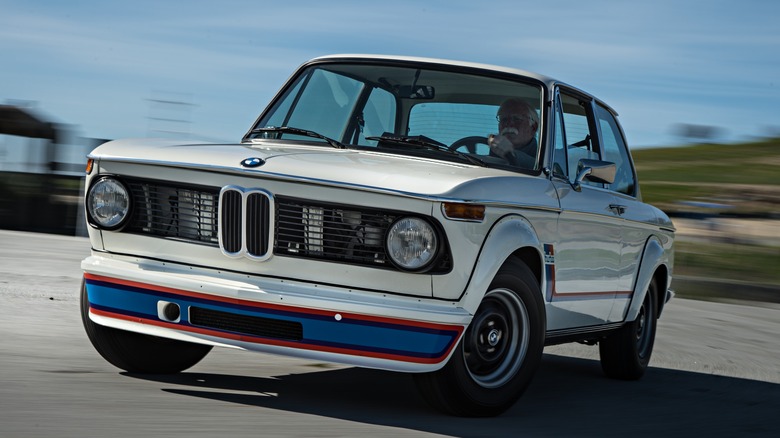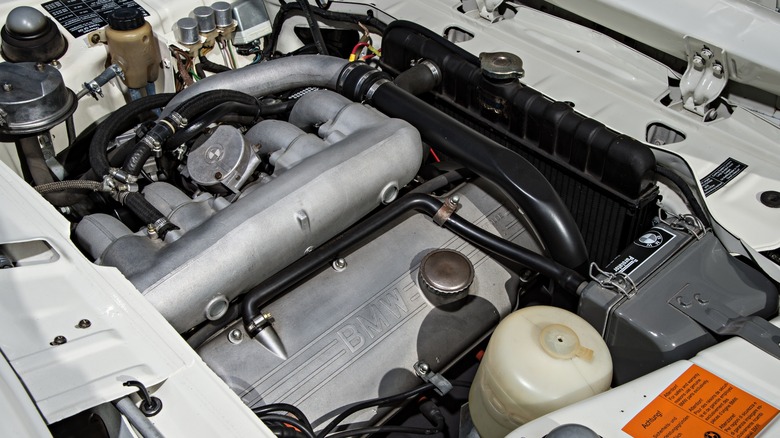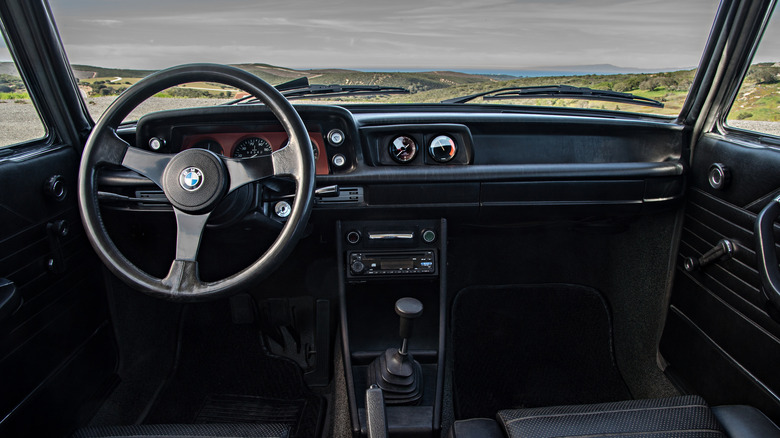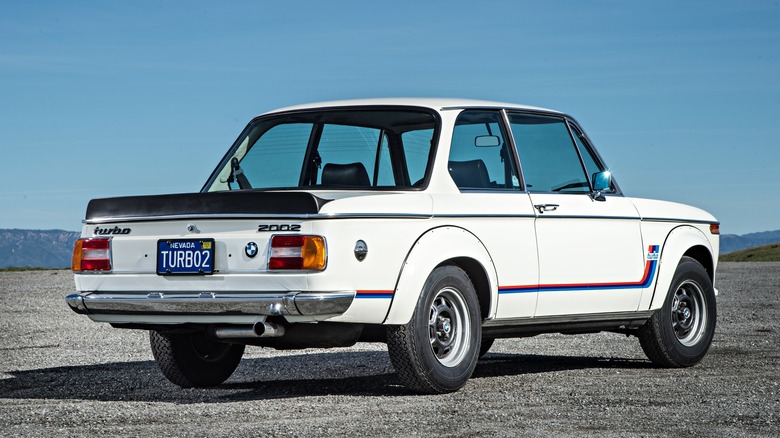Everything BMW Fans Should Know About The 2002 Turbo
The BMW 2002 Turbo was a groundbreaking vehicle. The Turbo represented the ultimate evolution of the BMW 2002, the vehicle that originally put BMW on the map as the purveyor of "The Ultimate Driving Machine." It was also the first BMW vehicle to use the now-famous tri-color "M" stripes. But most importantly, it was the first European production car to use an exhaust-driven turbocharger to boost its performance (some GM cars in the US offered turbocharging in the 1960s, but technical problems and poor sales caused their demise).
The BMW 2002 first arrived in the US in 1968, based on a shortened, 2-door version of the company's earlier New Class sedan. It was brought here through the efforts of Max Hoffman, the renowned importer of many European vehicles. Hoffman asked BMW to create a version with a larger, 2-liter engine that was suited to both our wide-open spaces and our tightening emissions regulations. The boxy, unassuming, great-handling, yet affordable BMW 2002 was a success in the marketplace, establishing BMW's performance cred among American enthusiasts.
The BMW 2002 Turbo was the most powerful 2002
The turbocharged version of the 2002 (appropriately named the BMW 2002 Turbo), was introduced at the Frankfurt, Germany Auto Show in 1973. It was produced from 1973 until 1975. In terms of performance, the 2002 Turbo was a quantum leap beyond the other production 2002s that had preceded it. The 2002 Turbo's engine was a further development of the 1,990cc M10 engine that powered its fellow 2002s. Based on the version that powered the high-performance 2002tii, the Turbo's engine added Kugelfischer mechanical fuel injection and a KKK turbocharger to boost the 2002 Turbo to 170 horsepower at 5200 RPM, an increase of 40 hp. Maximum torque was 173 ft./lb. at 4000 RPM. The compression ratio was reduced from the 2002 tii's 9.5:1 to a lower 6.9:1 in the 2002 Turbo to prevent detonation when the turbocharger was producing boost. The BMW 2002 Turbo was also equipped with a larger radiator and an oil cooler to reduce the heat load created by the turbocharger setup.
The nature of the 2002 Turbo's power delivery was characteristic of early, less-sophisticated turbocharged engines. The 2002 Turbo exhibited massive "turbo lag," a delay between the moment you depressed the accelerator and the time that the power you wanted was delivered. This was a result of the time required for the exhaust-driven turbo to "spool up" to the speed required to push the compressed fuel-air mixture into the cylinders. The power would typically kick in strongly around 4000 RPM, at which point a tight grip on the steering wheel was needed to avoid losing control.
BMW 2002 Turbo: chassis and body details
The BMW 2002 Turbo had some chassis enhancements to deal with its added horsepower and improve its handling. Upgraded front struts with Boge shock absorbers and a stabilizer bar were used, with Bilstein shocks available as an option. A limited-slip differential was also fitted. Standard wheels were 5.5" x 13" steelies, with 6" x13" alloys optional. The front disc brakes were ventilated and the rear drums were larger. The tire size was 185/70x13, which was a big deal at the time.
The body of the 2002 Turbo is noticeably different from other 2002s. It features a large front airdam, deletes the front bumper, and adds fiberglass fender flares allowing for wider wheels to be fitted. A trunk spoiler completes the effect, validating the appearance of the highest-performing BMW 2002. Available colors were limited to either Chamonix White or Polaris Silver. BMW added reversed-script "2002 turbo" decals to the front spoilers of their press cars, letting the driver of the car ahead know what was about to pass him. Unfortunately, there was a backlash against this in Germany when the cars were being driven by the motoring press, so this option never made it to production.
The BMW 2002 Turbo's interior was focused on the driver and included special sport seats, a leather-wrapped, three-spoke steering wheel, a red instrument panel surround, and a gauge cluster with a boost gauge and a clock in the center of the dash.
Bad timing doomed the BMW 2002 Turbo
If timing is everything, then bad timing was responsible for the ultimate failure of the BMW 2002 Turbo in the marketplace of the mid-1970s. Just as the 2002 Turbo was starting to be produced, the global oil crisis hit and turned the automotive world upside down. High performance was out and fuel economy was in. The 2002 Turbo's mechanical fuel injection had no computer controls, so the more air-fuel mixture that could be compressed by the turbocharger, the more power that could be produced. This was not the recipe for a fuel-efficient car. As the oil crisis took hold, Autobahn speed limits and car-free Sundays were put into effect in Germany. In the U.S., there were fuel shortages and odd/even-day gas rationing.
The 2002 Turbo's price was also an issue, with it costing about the same as a mid-size Mercedes-Benz sedan and 1/3 more than its 2002 tii sibling. A total of 1,672 BMW 2002 Turbos were produced (1,057 in white and 615 in silver), making them very rare collector's items today. Recent auction prices are in the $150,000-$220,000 range.
The BMW 2002 Turbo represents a milestone in performance cars and should be celebrated for what it accomplished. As the first turbocharged European production car, it set a pattern for the more advanced vehicles with computer-controlled, more fuel-efficient turbos that would follow it into the market a few years later, after oil prices started coming down from their peak.



